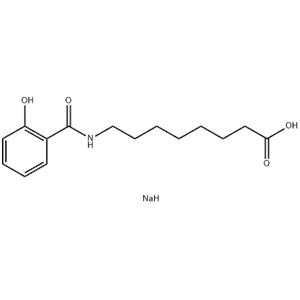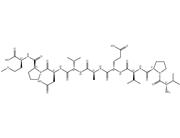Email: sales@anbuchem.com
Whatsapp:+8618638608485
24 hours online, Welcom to inquiry.
Salcaprozate Sodium Basic information
Product Name: Salcaprozate Sodium
Synonyms: sodium,8-[(2-hydroxybenzoyl)amino]octanoate;sodium 8-(2-hydroxybenzamido)octanoate;Octanoic acid, 8-[(2-hydroxybenzoyl)amino]-, monosodium salt;SNAC;SNAC,sodium 8-[(2-hydroxybenzoyl)amino]octanoate;Salcaprozate sodium;Salcaprozate Sodium (SNAC);SODIUM 8-(2-HYDROXYBENZAMIDO)OCTANOATE (SNAC)
CAS: 203787-91-1
MF: C15H22NNaO4
MW: 303.33
EINECS: 231-019-4
Product Categories: API;SNAC;pharmaceutical;203787-91-1
Mol File: 203787-91-1.mol
Salcaprozate Sodium Structure
Salcaprozate Sodium Chemical Properties
Melting point 183 - 185°C
storage temp. Inert atmosphere,Room Temperature
solubility DMSO (Slightly), Methanol (Slightly)
form Solid
color White to Off-White
Stability: Hygroscopic
InChI InChI=1S/C15H21NO4.Na.H/c17-13-9-6-5-8-12(13)15(20)16-11-7-3-1-2-4-10-14(18)19;;/h5-6,8-9,17H,1-4,7,10-11H2,(H,16,20)(H,18,19);;
InChIKey OBKUJEVXEMKQMJ-UHFFFAOYSA-N
SMILES C(C1C=CC=CC=1O)(=O)NCCCCCCCC(=O)O.[NaH]
Safety Information
MSDS Information
Salcaprozate Sodium Usage And Synthesis
Description Salcaprozate sodium (SNAC) is the sodium salt form of salcaprozate, an oral absorption promoter. Salcaprozate sodium may be used as a delivery agent to promote the oral absorption of certain macromolecules with poor bioavailability such as insulin and heparin.It is also used as an excipient in drug formulation as a chemical permeation enhancer (PE) to aid the oral absorption of macromolecules, peptides and proteins such as insulin (diabetes), heparin (heart attacks and angina) and cyanocobalamin (vitamin B12 deficiency and anaemia) which would otherwise have poor bioavailability. SNAC is considered to be safe for human consumption (GRAS) by the FDA.
Uses Oral absorption promoter.
Uses Salcaprozate Sodium is a drug excipient or inactive ingredient in drug formulations.
Definition Salcaprozate Sodium (SNAC) is a synthetic N-acetylated amino-acid derivative of salicylic acid. SNAC is a weak acid that display amphiphilicity and surface activity. It was discovered as part of a screen to identify carrier-based PEs that could “chaperone” poorly permeable payloads across the intestine. This compound is the most extensively tested carrier and the only PE approved in an oral formulation designed to improve oral BA, albeit with a small molecule, cyanocobalamin/SNAC. In other preclinical studies, it also improved intestinal permeation of peptides (salmon calcitonin (sCT) and insulin), along with poorly permeable small molecules (e.g., cromolyn). SNAC was tested in many formats: taste-masked liquids, tablets, and soft gelatin capsules. Similar to C10, SNAC can be blended with the active pharmaceutical ingredient (API) using conventional processes, which makes manufacturing uncoated oral tablet dosage forms economic and relatively easy to scale[1].
in vitro SNAC (12.5-400 μg/mL; 24 h) has no toxicity to Caco-2 cells, and the survival percentage is above 90% when SNAC is 200 μg/mL.
SNAC (50 and 200 μg/mL) improves the apparent permeability coeffcient (Papp) of RA and SA-B by 2.14-fold and 3.68-fold compared with the Papp of SAs solution.
in vivo SNAC improves the oral absorption of both R1 and SAs and enhances bioavailability in rats.
SNAC (2000 mg/kg/d; oral gavage for 13 weeks) related mortality is evident only at the 2000-mg/kg/d level, 20% among males and 50% among females; no clear cause of death is evident.
SNAC (100-1000 mg/kg/d; oral gavage for 13 weeks) induces no mortality in the Wistar rat study at doses up to 1000 mg/kg/d
Mode of action The mode of action of Salcaprozate Sodium is controversial, and many scientists have explored its mechanism from various angles. Theory of oral semaglutide absorption, as advocated by Novo Nordisk. The optimum once-daily tablet consists of 14 mg of semaglutide co-formulated with 300 mg of SNAC. After digestion, the tablet erodes rapidly in the stomach, resulting in the release of a highly concentrated amount of SNAC that neutralizes the pH of gastric fluid in the immediate vicinity of the tablet to inactivate pepsin. SNAC is thought to induce semaglutide monomer production and increase gastric epithelial membrane fluidity, but without affecting tight junctions, thereby allowing transcellular passage of semaglutide into systemic circulation. Part of the role of SNAC seemed to be to convert semaglutide to a more permeable monomeric form and it seems to perform this better when formulated in a stomach-specific tablet[1].SNAC forms a conjugate base at the pH of the small intestinal lumen, so it can undergo complexation via hydrophobic ion pairing (HIP) with the conjugate acid of basic amino-acid side chains in macromolecules. However, HIP cannot fully account for Eligen-mediated hydrophobization of anionic payloads including heparin and cromolyn.

 China
China



